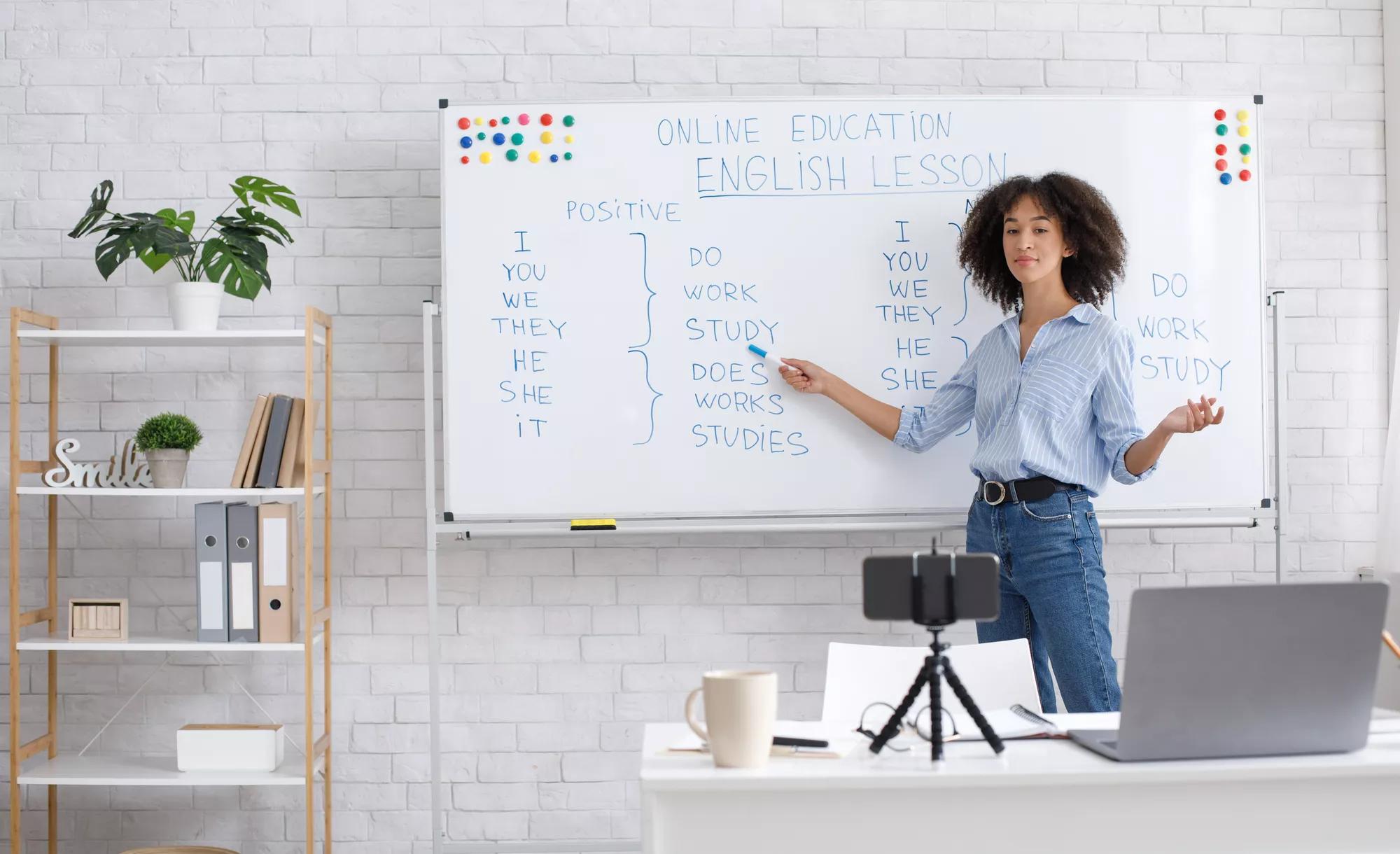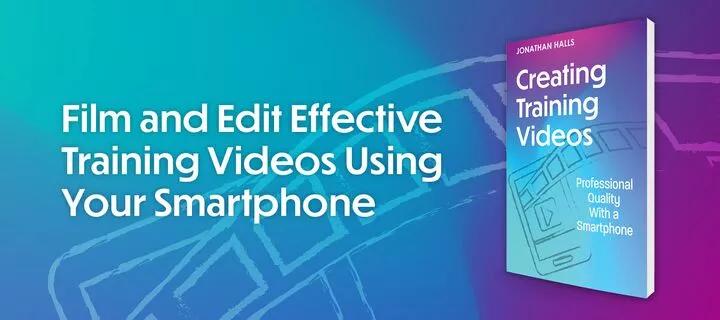ATD Blog
Create Your Own Training Videos to Make Learning More Effective
A Q&A with Jonathan Halls, author of Creating Training Videos: Professional Quality With a Smartphone.
Fri Apr 05 2024

With 96 percent of organizations using video as a key modality for workplace learning and 62 percent of organizations posting video (for L&D and other purposes) to YouTube, the ability to produce video is a sought-after skill in the L&D world. For insight and guidance, here's a Q&A with Jonathan Halls, author of Creating Training Videos.
1. What led you to write this new book, Creating Training Videos?
As new training tools have emerged during my 30-year career in talent development (TD), I have helped countless training professionals understand how to use them smartly to further learning and development initiatives. This is particularly true in the area of video production as an effective tool for L&D efforts. I wrote my first book on this topic, Rapid Video Development for Trainers, in 2012, at a time when the concept of creating instructional video was relatively new. So much has changed since 2012, and there is a need for a new book on creating training videos. While the principles of effective instructional video remain the same, the advancements in technology since that time make video production easier. Another change is that the use of videos to support learning is much more dynamic. This is key because the learning needs of today’s fast-changing organizations have evolved too. For example, 10 years ago, many training videos were simple screen captures or talking heads embedded in e-learning modules. Today, they are part of on-demand learning libraries where people access them at their time of need. Some even include user-generated video, which allows content to remain up to date and extremely relevant to workplace needs.
In a sense, Creating Training Videos is an update to my first book, albeit focused on how to make video inexpensively—with a cell phone and “cheap as chips” online video editors. When I wrote Rapid Video Development for Trainers, hardly anyone was making DIY videos. That book was written to nudge folks into the world of self-made instructional videos. Since 2012, we’ve learned a lot about everything from workflow to how to work with subject matter experts without them taking over the production process. Today, most organizations create their own video content, in one form or another, focused on specific organizational needs. While some may hire external contractors or production companies to do it, it’s not necessary for most content. Armed with a smartphone and affordable video editor, trainers can easily put together video content that helps people learn. This can save a lot of money. In Creating Training Videos, I provide guidance around these areas.
I am deeply passionate about the intersection of learning and media. I started my work life as a broadcaster and have never lost the content-making bug. I want to share my experience with instructional designers and trainers to help them improve their skills in creating and delivering content that sticks with their learners and helps meet their organizational goals.
2. How do training videos fit into the bigger picture of talent development?
When I attended my first “train-the-trainer” training back in 1990, facilitators taught us how to use charts and colored markers to present information. That was our technology! Today, video is our technology.
What is terrific for trainers is that we now can film tasks performed in the workplace— bringing the real world of work into the learning experience while saving folks from taking field trips. We can also craft content that takes learning from the training department into the workplace where folks can access it on demand.
The use of videos can also be a powerful tool for building better organizations, but only when created and deployed properly. My consulting, coaching, and facilitation work is focused on organizational effectiveness and how to help build capability—whether it’s restructuring a training department, developing an integrated talent strategy, or running workshops on learning science. Through this lens, I explore when and when not to use video. I contend that even when video might seem like a good solution, it can be ineffective if it is poorly structured or produced in an ad hoc way. Done well and used in the right situations, it helps trainers and talent or learning functions become more agile. Video production capability should be a key skill every trainer has, and I recommend that every train-the-trainer program have a module on how to craft digital content, right after the session on writing on a wall chart!
3. What have you learned that has most inspired you?
We can learn a lot from how professional TV and film is produced but must remember that TV dramas and other genres are produced for different reasons. Editorial and production decisions for a TV drama might be based on slowly revealing a narrative or exposing a social concern. Training videos exist to help people perform tasks and skills and have different nuances. The first—and most consequential—question I implore budding L&D video creators to ask is: Does this video help folks learn to perform a new skill?
If the video is not structured carefully, it will make learning more difficult. An example of a poorly structured video is the stream-of-conscious video where people effectively do a show-and-tell demo. We don’t let trainers wing it in the classroom, right? We expect them to prepare the content and to structure the learning experience to cater to the learners’ needs and experience levels. The same applies to video.
I share several structures for folks to use either as a template or the basis of their own creativity to make this part of the process easy. Good video is structured to make the task the viewer wants to learn quick and easy to understand and remember. Folks will often spend three or four hours producing one minute of quality video—emphasis on the word quality. We’re talking a day’s production for a two- or two-and-a-half-minute video. The use of artificial intelligence (AI) will help speed up the process, but producing effective video takes time. If we’re going to put the time in, we should put it in well.
4. You suggest video production takes a lot of time—are there any shortcuts?
You can save time by spending more time up front in planning. I once asked a BBC colleague what he thought the most important skill for production is. He’d produced and directed live TV, documentaries, and dramas. I expected him to say something like creativity or imagination. He said, “Jonathan, there are three things: planning, planning, and planning.”
Inherent in efficient production is a good workflow, so routine tasks become a habit, almost automatic. Once they’re a habit, you do them without thinking and have more bandwidth to focus on the creative side. In this book, I share a workflow tailored specifically to learning that is formed from a media mindset. While many people produce workflows that are glorified project management lists with milestones and deliverables, those workflows often disorder the tasks. An example of this is writing a script before thinking about the pictures. This wastes time and leads to inconsistent content. I explain why in a chapter of my book.
5. What would you say is the magic of video?
The magic of video is its pictures. By pictures, I mean moving pictures! When it comes to video, people remember more of what they see than of what they hear. What we show people is the most important element of video. When people look at me quizzically when I say that, I ask them to picture the last time they watched a weather forecast on TV. Can they remember what the meteorologist said? Usually not, but they can remember the images, the icons of fluffy clouds and smiling sun.
The same can be said of talking head videos—most of what someone says will be forgotten, but the viewer will remember what the speaker looks like. The magic happens when we start showing the content. To drive that point home, I like to quote Alfred Hitchcock, who understood this well. He said that “the silent picture is the purist form of cinema.”
Just as talking requires a complex system of grammar, so does video. It has its own language. This is a big part of my new book: How can we use the language of pictures to help people learn? It involves drawing together both learning and media theory and practice.
Get a copy of the book, Creating Training Videos, when you enroll in ATD's Filming & Editing Training Videos Certificate.
Gain the confidence to shoot and edit your own training videos.
About the Author
Talent development (TD) expert Jonathan Halls runs a TD practice and is an adjunct professor at George Washington University. Through the lens of evidence-informed approaches to corporate learning, he focuses on coaching and workshops for trainers, and consulting and strategic support for learning managers and directors. He is an award-winning author whose books include Rapid Video Development for Trainers, Rapid Media Development for Trainers, and Confessions of a Corporate Trainer, all published by ATD Press.
About ATD Press
The Association for Talent Development (ATD) is the world’s largest association dedicated to those who develop talent in organizations. ATD’s members come from more than 120 countries and work in public and private organizations in every industry sector. ATD Press publications are written by industry thought leaders and offer anyone who works with adult learners the best practices, academic theory, and guidance necessary to move the profession forward. For more information, visit td.org/books.
Creating Training Videos: Professional Quality With a Smartphone
ISBN: 9781953946966 | 280 Pages | Paperback
To order books from ATD Press, call 800.628.2783.

